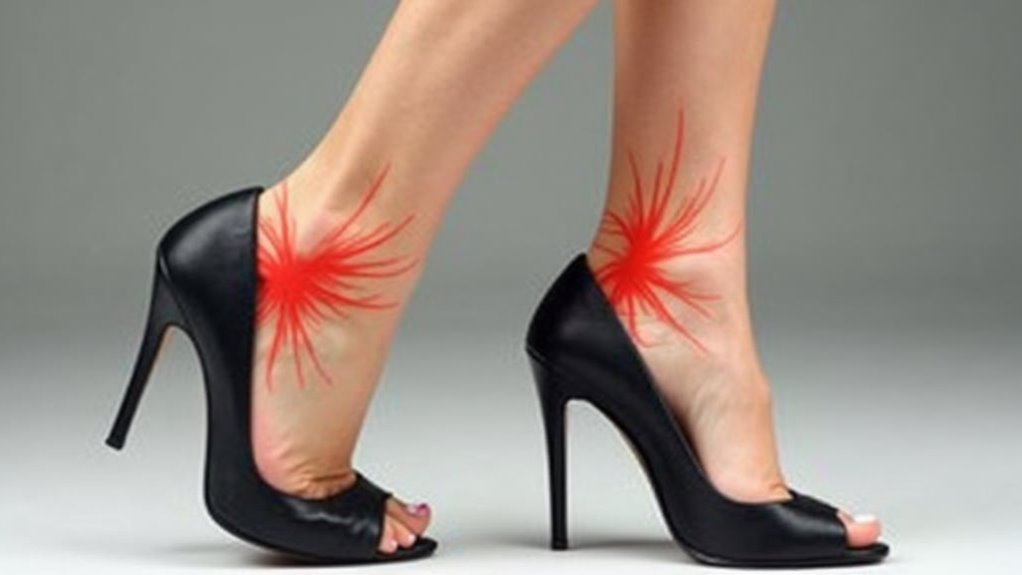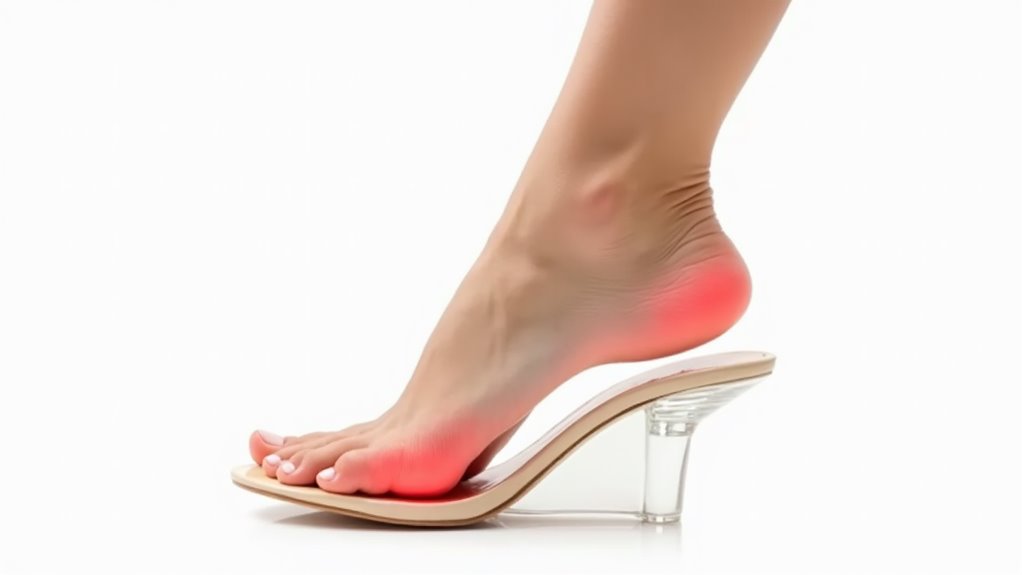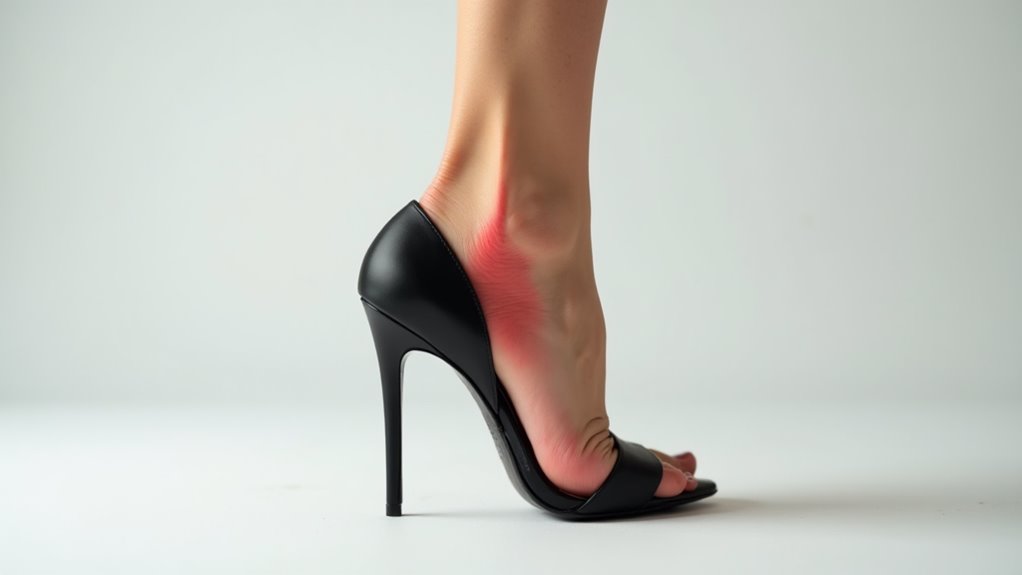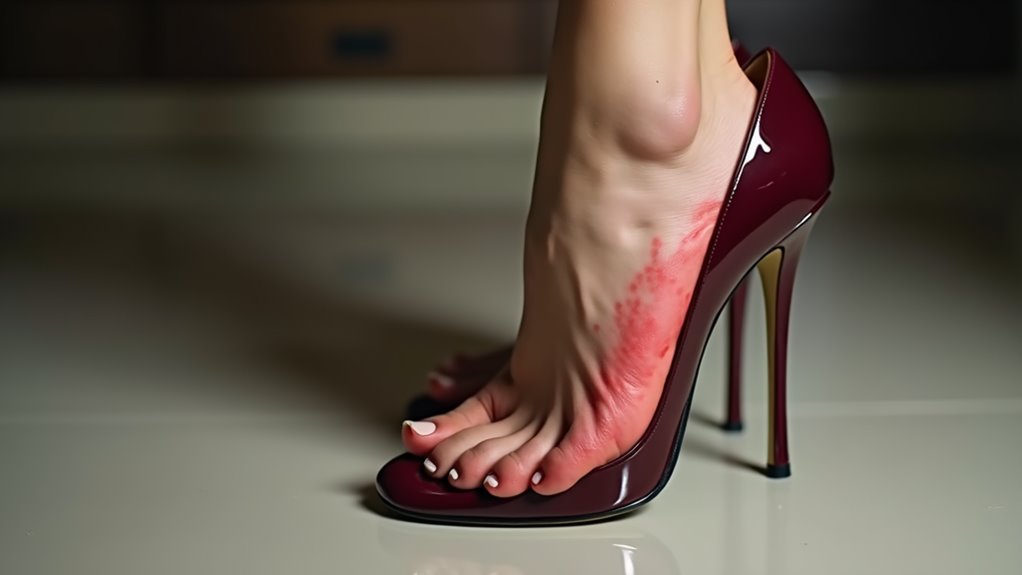There may be products. Products are independently selected by our editors. We may earn an affiliate commission from the links with no charge to you, example: as Amazon Affiliate.
Your choice of heel height isn’t just about style – it’s a crucial factor in your overall foot health and comfort. While you might love those sky-high stilettos or feel most comfortable in flats, wearing the wrong heel height for your specific foot type can lead to a cascade of problems beyond mere discomfort. From subtle changes in your walking pattern to the development of chronic pain, your body sends clear signals when your heels aren’t the right match. Understanding these warning signs can save you from potential long-term complications and help you make smarter footwear decisions.
Key Takeaways
- Persistent blisters or calluses form on your feet, especially around the ball of the foot or toes.
- Your walking style becomes unnatural or unstable after wearing the heels for a short period.
- You experience foot and ankle pain within an hour of wearing the shoes.
- Your heels slip out while walking, or your toes feel uncomfortably cramped in the front.
- Your back or knee pain increases, indicating poor body alignment due to inappropriate heel height.
Understanding Your Foot Type

Before choosing the perfect heel height for your shoes, you’ll need to understand your unique foot type.
Your feet can be categorized based on both their structural characteristics and toe shape patterns.
Look at your arch type first – you might’ve high arches with outward-rolling heels, decreased arches with slight twisting, neutral arches with outward rotation, or flat feet with no arch.
Then examine your toe pattern. You’ll have either Egyptian feet with a longer big toe, Greek feet with a longer second toe, Roman feet with three similar-length toes, or Square feet where all toes are nearly equal.
These characteristics affect how your feet distribute weight and move, which directly impacts your comfort in different heel heights. Understanding your specific foot type helps prevent discomfort and potential foot problems.
Finding formal heels with cushioning can significantly improve your comfort level while maintaining a professional appearance.
Common Signs of Discomfort
Recognizing signs of discomfort early can help prevent serious foot problems. If you’re experiencing blisters or calluses, it’s likely your shoes are rubbing against your feet due to improper heel height.
Pay attention to foot and ankle pain, which can signal issues like bunions or plantar fasciitis from wearing the wrong heel height.
You’ll notice changes in how you walk when your heels aren’t right for your foot type. High heels shift weight to your toes, while low heels can strain your back and shoulders.
Your natural stride may change to compensate for discomfort, leading to misalignment throughout your body.
Don’t ignore these warning signs, as they can lead to long-term damage. Without proper support, you’re risking chronic pain in your feet, knees, hips, and back.
For special occasions, consider investing in stunning formal heels that properly support your foot type while elevating your look.
Measuring Perfect Heel Height

Once you’ve identified signs that your heel height isn’t working, finding the right measurement can prevent future discomfort. Start by sitting in a chair with your back straight and knees at 90 degrees. Extend one leg and relax your foot, then measure from your heel to the ball of your foot with a measuring tape.
Consider your foot’s natural incline and flexibility when determining ideal height. If you’re measuring platform shoes, subtract the platform height from the heel height to get the true elevation. For wedges, measure from where the back touches the ground to where it meets the sole.
You’ll want to account for your specific foot characteristics, including arch height and foot width. Modern comfort technology heels provide enhanced support while maintaining style.
Most people find comfort in mid-height heels (2-3 inches), but your ideal measurement may vary based on foot type and flexibility.
Impact on Body Alignment
When you wear high heels, your entire body must compensate for dramatic shifts in posture, starting with your feet and moving up through your spine.
You’ll notice increased pressure on your joints, particularly in your knees and lower back, as your body works to maintain balance against unnatural angles.
Your spine compresses differently and your muscles strain to support this altered alignment, which can lead to long-term postural changes if you frequently wear heels.
Finding comfort-focused heel designs can help minimize these postural strains while still maintaining style.
Posture Changes From Heels
High heels dramatically alter your body’s natural alignment, starting with a forward shift in your center of gravity.
When you wear heels, your body compensates by arching your lower back more than usual, which creates a chain reaction of postural changes. Your pelvis tilts forward, your head moves forward, and your knees may angle inward.
These changes become more problematic as you age, particularly affecting your spine.
Your neck curve increases, and your erector spinae muscles work overtime to maintain balance. You’ll notice increased pressure on your forefoot and heightened muscle activity in your lower back.
If you’re wearing heels higher than 2 inches for extended periods, you’re likely putting excessive strain on your vertebral discs, joints, and back ligaments.
Spine Compression And Stress
Your spine bears the brunt of wearing elevated heels, experiencing up to 76% more pressure compared to lower heel heights. When you’re wearing high heels, your spine’s natural alignment shifts dramatically, forcing your pelvis and upper body into unnatural positions that can lead to permanent damage.
| Impact Area | Short-Term Effects | Long-Term Risks |
|---|---|---|
| Upper Spine | Neck strain | Kyphosis (hunching) |
| Mid Spine | Postural changes | Degenerative disease |
| Lower Spine | Increased pressure | Hyperlordosis |
| Pelvis | Alignment disruption | Chronic pain |
| Vertebral Discs | Uneven compression | Spinal stenosis |
You’ll notice these effects even more if you’re wearing heels over 2 inches tall, as they create excessive stress on your lumbar region and can trigger lasting spinal conditions like spondylolisthesis.
Joint Strain Distribution
Standing in elevated heels dramatically alters your body’s natural alignment, creating a cascade of strain throughout multiple joint systems.
Your knees experience increased bone-on-bone forces and greater flexion during heel strike, while your ankles are forced into extreme plantarflexion with heightened inversion angles.
You’ll notice your body weight shifting forward onto the balls of your feet, making balance more challenging as your center of gravity changes.
This unnatural positioning doesn’t just affect your lower extremities – it impacts your entire posture. Your spine compensates differently based on your age, with younger women showing increased lumbar lordosis and middle-aged women experiencing higher lumbar muscle activity.
Over time, these adaptations can lead to muscle shortening, increased fall risk, and potential joint problems like knee osteoarthritis.
Choosing the Right Support

Your arch type plays a crucial role in determining the support you’ll need in heels, whether you have high, normal, or flat feet.
You’ll want to match your footwear’s support level to your specific arch needs – consider adding orthopedic insoles for enhanced comfort and stability.
Finding your ideal comfort zone means testing different heel heights between 2-3 inches, paying attention to how your feet feel after wearing them for short periods.
Look for heels with supportive heel design that provides proper cushioning and weight distribution throughout the day.
Arch Support Matters Most
While heel height plays a crucial role in shoe comfort, proper arch support remains the cornerstone of foot health.
You’ll find that inadequate support leads to more than just foot discomfort – it can trigger knee pain, lower back issues, and plantar fasciitis.
To determine your arch type, try the wet footprint test on cardboard. If you see about half of your arch, you’ve got neutral arches. A complete footprint indicates flat feet, while minimal contact suggests high arches.
Each type needs specific support: flat feet require motion control, high arches need extra cushioning, and neutral arches benefit from firm midsoles.
Whether you’re using custom insoles or high-tech arch supports, matching the support to your foot type is essential for preventing injuries and maintaining comfort throughout your day.
Finding Your Comfort Zone
To discover your ideal heel height, start by examining the natural flexibility of your feet and understanding your arch type. If you’ve got high arches, you’ll likely find comfort in heels between 3-5 inches, while flat feet typically feel better in lower 2-3 inch options. Pay attention to how your feet respond in different heel heights and styles.
- Your feet shouldn’t ache after just an hour – if they do, you’re wearing the wrong height.
- You shouldn’t feel pressure points or pinching at the ball of your foot.
- Your heel shouldn’t slip out when walking, and your toes shouldn’t feel cramped.
Remember that the PHH formula considers your Talus bone flexibility, so work with a professional to measure this if you’re uncertain.
Choose heels with an arch of less than 160 degrees to ensure proper weight distribution and all-day comfort.
Long Term Effects
Wearing high heels regularly can lead to serious long-term foot problems that extend far beyond temporary discomfort.
You’re likely to develop painful conditions like metatarsalgia, stress fractures, and bunions from the constant pressure on your feet’s balls and toes. Your calf muscles may tighten, and your Achilles tendon could shorten, making it uncomfortable to wear flat shoes.
Your body’s natural alignment suffers too.
You’ll notice changes in your walking pattern, increased risk of ankle sprains, and potential joint problems from knees to lower back. The higher your heels, the greater these risks become.
If you can’t give up heels entirely, choose ones under 3 inches with wide toe boxes and good arch support.
Consider platforms with minimal height difference between front and back to reduce strain.
Making the switch to sustainable heel materials can provide comfort while being environmentally conscious.
Conclusion
You’ll notice immediate improvements in posture and comfort when you switch to the right heel height for your foot type. Take Sarah, a retail manager who suffered from chronic lower back pain until she discovered her high arches required a moderate 2-inch heel. By matching her footwear to her anatomy, she eliminated her daily discomfort and now confidently works 10-hour shifts without pain.

